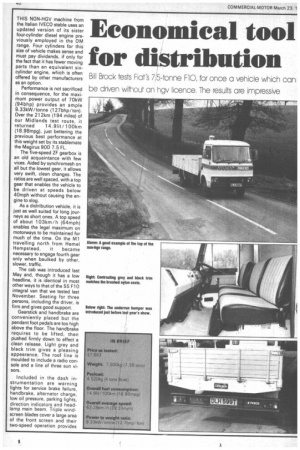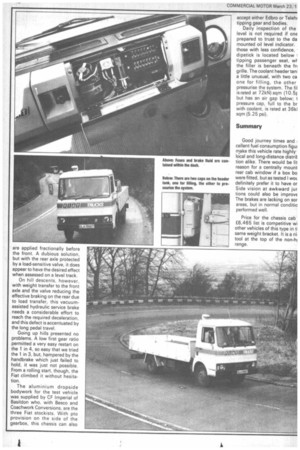Economical tool for distribution
Page 42

Page 43

Page 44

If you've noticed an error in this article please click here to report it so we can fix it.
Bill Brock tests Fiat's 7/5-tonne HO, for once a vehicle which can be driven wi out an hgv licence. The results are impressive
THIS NON-HGV machine from the Italian IVECO stable uses an updated version of its sister four-cylinder diesel engine previously employed in the OM range. Four cylinders for this size of vehicle makes sense and must pay dividends, if only for the fact that it has fewer moving parts than an equivalent sixcylinder engine, which is often offered by other manufacturers as an option.
Performance is not sacrificed in consequence, for the maximum power output of 70kW (94bhp) provides an ample 9.33kW/tonne (127bhp /ton). Over the 212km (194 miles) of our Midlands test route, it returned 14.9Iit/ 100km (18.98mpg), just bettering the previous best performance at this weight set by its stablemate the Magirus 90D 7.5 FL.
The five-speed ZF gearbox is an old acquaintance with few vices. Aided by synchromesh on all but the lowest gear, it allows very swift, clean changes. The ratios are well spaced, with a top gear that enables the vehicle to be driven at speeds below 40mph without causing the engine to slog.
As a distribution vehicle, it is just as well suited for long journeys as short ones. A top speed of about 103km / h (64mph) enables the legal maximum on motorways to be maintained for much of the time. On the M1 travelling north from Hemel Hempstead, it became necessary to engage fourth gear only when baulked by other, slower, traffic.
The cab was introduced last May and, though it has a low headline, it is identical in most other ways to that of the 55 F10 integral van that we tested last November. Seating for three persons, including the driver, is firm and gives good support.
Gearstick and handbrake are conveniently placed but the pendant foot pedals are too high above the floor. The handbrake requires to be lifted, then pushed firmly down to effect a clean release. Light grey and black trim gives a pleasing appearance. The roof line is moulded to include a radio console and a line of three sun visors.
Included in the dash instrumentation are warning lights for service brake failure, handbrake, alternator charge, low oil pressure, parking lights, direction indicators and headlamp main beam. Triple windscreen blades cover a large area of the front screen and their two-speed operation provides
excellent forward vision even under very wet conditions.
Two small windows in the back panel, one on either side, are a poor substitute for a good sized centrally mounted window. A window in the side panel to the rear of the nearside door would be useful, as on the 5.5 integral van, and would allow better vision at acute road Junctions.
A grab-handle fixed to the roof is convenient for the passenger in the middle and doubles as a support for the double passenger seat when it is raised to expose the engine.
The noise level in the cab was not objectionable and the radio could be heard without difficulty above it.
Access is an important factor with distribution vehicles and I found no fault here. The fronthinged door opened wide and the single step was at a good height.
On the road section of the test, I found the vehicle's steering responsive with a good feel, but perhaps a little too low-geared. This aspect is particularly noticeable at roundabouts, where the wheel has to be shuffled quite a lot through the hands.
It is best to select first gear on all occasions when moving off from rest as, although in some instances second will cope, the reverse slot is all too easy to locate by mistake.
On the test track, maximum braking produced some good results. It was not until later, on some of the long hill descents, that the shortcomings of the braking system showed up. In the past, we have heard how easily the front wheels lock up.
To counteract this, I am told, a delay has been built into the system, so that the rear brakes are applied fractionally before the front. A dubious solution, but with the rear axle protected by a load-sensitive valve, it does appear to have the desired effect when assessed on a level track.
On hill descents, however, with weight transfer to the front axle and the valve reducing the effective braking on the rear due to load transfer, this vacuumassisted hydraulic service brake needs a considerable effort to reach the required deceleration, and this defect is accentuated by the long pedal travel.
Going up hills presented no problems. A low first gear ratio permitted a very easy restart on the 1 in 4, so easy that we tried the 1 in 3, but, hampered by the handbrake which just failed to hold, it was just not possible. From a rolling start, though, the Fiat climbed it without hesitation.
The aluminium dropside bodywork for the test vehicle was supplied by CF Imperial of Basildon who, with Besco and Coachwork Conversions, are the three Fiat stockists. With pto provision on the side of the gearbox, this chassis can also accept either Edbro or Telehi tipping gear and bodies.
Daily inspection of the level is not required if one prepared to trust to the da mounted oil level indicator. those with less confidence, dipstick is located below tipping passenger seat, wlthe filler is beneath the fri grille. The coolant header tani a little unusual, with two ca one for filling, the other pressurise the system. The fil is rated at 72kN) sqm (10.5r but has an air gap below; t pressure cap, full to the br with coolant, is rated at 36k1 sqm (5.25 psi).
Summary
Good journey times and cellent fuel consumption figui make this vehicle rate highly local and long-distance distrit tion alike. There would be lit reason for a centrally mount rear cab window if a box bo were fitted, but as testedlwot definitely prefer it to have or Side vision at awkward jur tions could also be improve The brakes are lacking on sor areas, but in normal conditio performed well.
Price for the chassis cab £6,465 list is competitive wi other vehicles of this type in ti same weight bracket. It is a ni tool at the top of the non-h! range.
















































































































